Launching Ricky Into Space
Bill Dennison ·Ricky Arnold, a former graduate student at Horn Point Laboratory, University of Maryland Center for Environmental Science, stopped by Cambridge, Maryland on his way to the Wallops Island NASA facility. Ricky's last time in Cambridge was his thesis defense, nearly twenty years ago. Since his thesis defense, Ricky has lived in several countries, including Indonesia and Morocco, but has been in Houston, Texas for the past 6 years. Ricky joined NASA as an educator astronaut and made a trip to the International Space Station aboard the space shuttle Discovery last year. As Ricky's former graduate advisor, Judy (also Ricky's friend) and I were invited to join his family and friends in Florida for the launch, so we made a family trip to Cape Canaveral.

On March 15, 2009, after multiple delays and a scrubbed launch that was hours from liftoff, we found ourselves at the NASA viewing stands watching the large countdown clock tick off the final seconds before the launch of the space shuttle Discovery. It was a balmy evening at Cape Canaveral on Sunday evening, March 15 and the sun had set moments before the 7.43 pm launch. The clouds present during the day had dissipated so we had a clear sky and a gentle sea breeze coming across the marshes and Banana Creek. The first thing that we saw was a silent bright glow coming from the launch site, which glowed like the sun at sunrise. As the glow lit up the Discovery and its rocket boosters and they began to lift off the launch pad, we began to both feel and hear the low rumble of the space shuttle rockets. We had been standing for the final several minutes of the countdown and the crowd began to cheer; it reminded me of the home team scoring a touchdown. NASA staff had briefed us on the rotational turn that the rockets would make and the relatively low trajectory that Discovery was making so that they could rendezvous with the International Space Station. So we were not surprised at the twisting motion and the path that Discovery was taking to the northeast out over the Atlantic Ocean. The trail of smoke left by Discovery changed color from blue-grey near the launch pad to bright yellow-orange as the setting sunlight caught it to bright white directly behind Discovery. After singing the Star Spangled Banner a few minutes before lift off, the Discovery smoke trail made us think of it as a red, white and blue tribute. After a couple of minutes, we were able to see the two solid rocket boosters drop off and begin their descent to the sea surface, where NASA would recover them for reuse. At this point, another cheer erupted, as we were assured that the Discovery had successfully begun its mission.

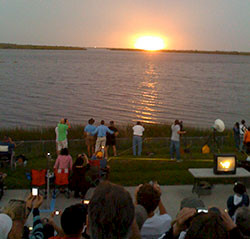
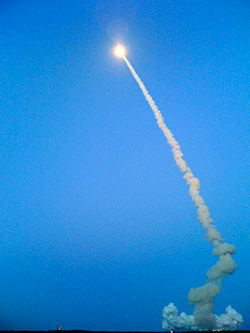
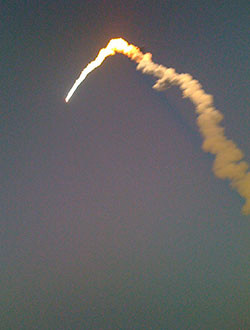
At the launch, we were able to meet families and friends of each of the seven astronauts that comprised the crew of STS-119. It was from these encounters that we were able to glean that each of these astronauts had a strong support network of family and friends who were incredibly proud of their respective astronaut. These seven individuals had attracted literally hundreds of people to Florida to view the launch, and even the Japanese astronaut had a large contingent of visitors from Japan. What was also apparent was that the astronauts had been selected for their multiple talents and skills, their engaging and affable personalities, their intelligence and their physical prowess. These smart, fit and intelligent people selected by NASA all were clearly thoroughly enjoying themselves and their enthusiasm for what they were doing had spread contagiously to all of us assembled in Florida.
During Ricky's mission we were glued to the NASA TV website, watching him conduct space walks to install solar panels, and listening to him talk with Houston in real time, 200 miles above earth. We enjoyed listening to the Discovery crew get woken up each morning with their favorite musical selection. We watched the Discovery crew enter the International Space Station for the first time (with the clanging of the bell). We laughed when the crew joked with President Obama and a bunch of school kids from the East Room of the White House, and almost died laughing when Ricky said that he missed his pillow when he slept in space. When the mission was over, we watched with bated breath when Discovery landed in Florida, after an extra lap around to world due to bad weather. As Discovery's parachute popped open on the runway at Cape Canaveral, we exhaled, and realized that we had been collectively holding our breath for 2 weeks.
As I learned more about Ricky's life as an astronaut, I could see that his marine biology training has served him well. Ricky was a good scuba diver, and mastering the technical, physiological and psychological aspects of diving provided good training for life support systems required for living in space and conducting space walks. Ricky was also a good sailor, and mastering life in confined spaces involving intimate contact with shipmates and potential motion sickness provided good training for space travel. Ricky took a photo from space of Bermuda, where we spent a good part of a summer at the Bermuda Biostation together studying seagrasses, corals and mangroves. Ricky was an excellent graduate student, and his ability to learn new techniques and approaches and develop good communication skills serve him well as one of the two educator astronauts on STS-119.
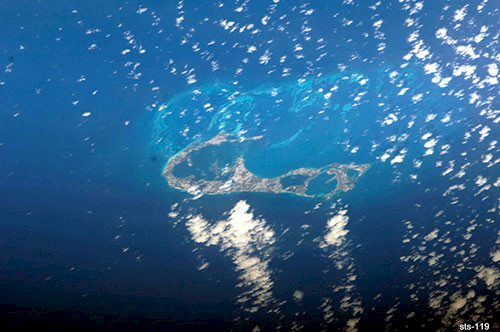
Ricky graciously accepted our invitation to attend the Marine Environmental Estuarine Sciences annual graduate student Colloquium which the Integration and Application Network hosted in Annapolis in November 2009. This was quite fitting, in that Ricky's graduate degree was from this program. Ricky showed us a short video of his mission and then conducted a mesmerizing question and answer session about space flight. Ricky presented us with a UMCES flag, which he took with him on the Discovery—a wonderful gesture.
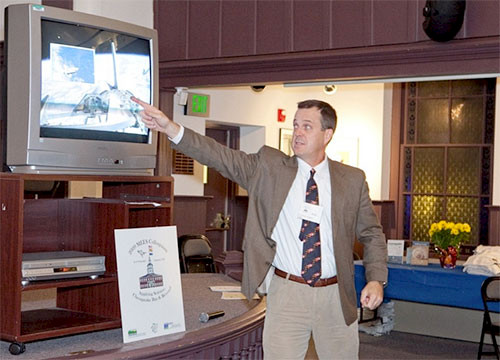

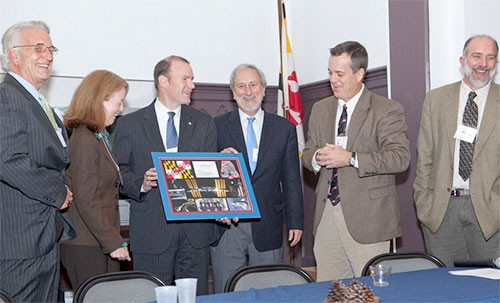
Ricky Arnold began his scientific career plumbing the depths of Chesapeake Bay to construct a paleohistory of aquatic grasses, and published his results in an international peer reviewed scientific journal (Journal of Coastal Research 16(1) 188-195). Nearly two decades later, Ricky was a couple of hundred of miles above the earth's surface conducting experiments in space. Ricky's mission also delivered the two remaining solar panels to boost the power supply at the International Space Station so that six, rather than three scientists can live at the station. In addition, Ricky spent fifteen years as a science educator in various different countries, sharing his enthusiasm for science with scores of students. This combined impact that Ricky is making on science dwarfs that of most people that I know, including myself. I wonder at how fortunate I am to have served as Ricky's graduate student advisor.
About the author
Bill Dennison

Dr. Bill Dennison is a Professor of Marine Science and Vice President for Science Application at the University of Maryland Center for Environmental Science.


